
dom-to-semantic-markdown
DOM to Semantic-Markdown for use with LLMs
Stars: 708
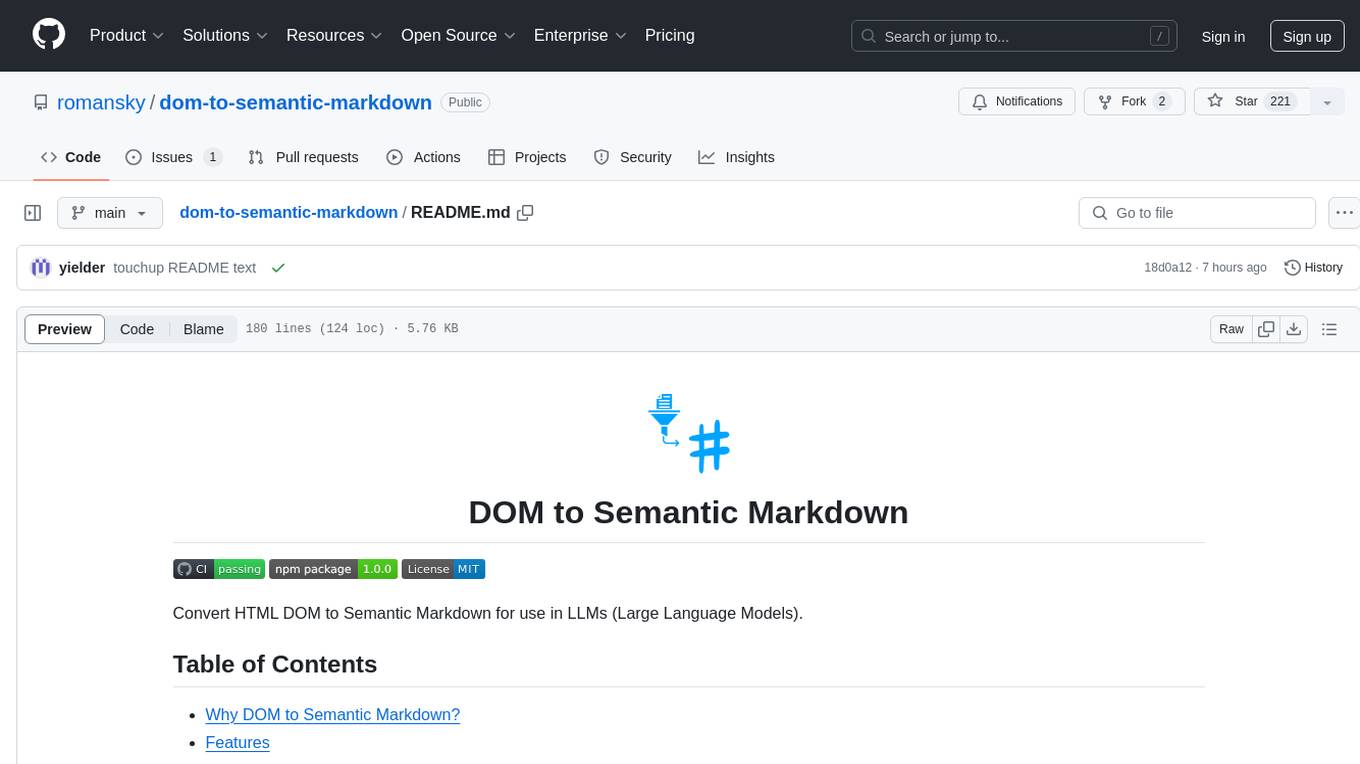
DOM to Semantic Markdown is a tool that converts HTML DOM to Semantic Markdown for use in Large Language Models (LLMs). It maximizes semantic information, token efficiency, and preserves metadata to enhance LLMs' processing capabilities. The tool captures rich web content structure, including semantic tags, image metadata, table structures, and link destinations. It offers customizable conversion options and supports both browser and Node.js environments.
README:
This library converts HTML DOM to a semantic Markdown format optimized for use with Large Language Models (LLMs). It preserves the semantic structure of web content, extracts essential metadata, and reduces token usage compared to raw HTML, making it easier for LLMs to understand and process information.
-
Semantic Structure Preservation: Retains the meaning of HTML elements like
<header>,<footer>,<nav>, and more. - Metadata Extraction: Captures important metadata such as title, description, keywords, Open Graph tags, Twitter Card tags, and JSON-LD data.
- Token Efficiency: Optimizes for token usage through URL refification and concise representation of content.
- Main Content Detection: Automatically identifies and extracts the primary content section of a webpage.
- Table Column Tracking: Adds unique identifiers to table columns, improving LLM's ability to correlate data across rows.
Here are examples showcasing the library's special features using the CLI tool:
1. Simple Content Extraction:
npx d2m@latest -u https://xkcd.comThis command fetches https://xkcd.com and converts it to Markdown
Click to view the output
- [Archive](/archive)
- [What If?](https://what-if.xkcd.com/)
- [About](/about)
- [Feed](/atom.xml) • [Email](/newsletter/)
- [TW](https://twitter.com/xkcd/) • [FB](https://www.facebook.com/TheXKCD/)
• [IG](https://www.instagram.com/xkcd/)
- [-Books-](/books/)
- [What If? 2](/what-if-2/)
- [WI?](/what-if/) • [TE](/thing-explainer/) • [HT](/how-to/)
<a href="/"></a> A webcomic of romance,
sarcasm, math, and language. [Special 10th anniversary edition of WHAT IF?](https://xkcd.com/what-if/) —revised and
annotated with brand-new illustrations and answers to important questions you never thought to ask—coming from
November 2024. Preorder [here](https://bit.ly/WhatIf10th) ! Exam Numbers
- [|<](/1/)
- [< Prev](/2965/)
- [Random](//c.xkcd.com/random/comic/)
- [Next >](about:blank#)
- [>|](/)

- [|<](/1/)
- [< Prev](/2965/)
- [Random](//c.xkcd.com/random/comic/)
- [Next >](about:blank#)
- [>|](/)
Permanent link to this comic: [https://xkcd.com/2966/](https://xkcd.com/2966)
Image URL (for
hotlinking/embedding): [https://imgs.xkcd.com/comics/exam_numbers.png](https://imgs.xkcd.com/comics/exam_numbers.png)
<a href="//xkcd.com/1732/"></a>
[RSS Feed](/rss.xml) - [Atom Feed](/atom.xml) - [Email](/newsletter/)
Comics I enjoy:
[Three Word Phrase](http://threewordphrase.com/) , [SMBC](https://www.smbc-comics.com/) , [Dinosaur Comics](https://www.qwantz.com/) , [Oglaf](https://oglaf.com/) (
nsfw), [A Softer World](https://www.asofterworld.com/) , [Buttersafe](https://buttersafe.com/) , [Perry Bible Fellowship](https://pbfcomics.com/) , [Questionable Content](https://questionablecontent.net/) , [Buttercup Festival](http://www.buttercupfestival.com/) , [Homestuck](https://www.homestuck.com/) , [Junior Scientist Power Hour](https://www.jspowerhour.com/)
Other things:
[Tips on technology and government](https://medium.com/civic-tech-thoughts-from-joshdata/so-you-want-to-reform-democracy-7f3b1ef10597) ,
[Climate FAQ](https://www.nytimes.com/interactive/2017/climate/what-is-climate-change.html) , [Katharine Hayhoe](https://twitter.com/KHayhoe)
xkcd.com is best viewed with Netscape Navigator 4.0 or below on a Pentium 3±1 emulated in Javascript on an Apple IIGS
at a screen resolution of 1024x1. Please enable your ad blockers, disable high-heat drying, and remove your device
from Airplane Mode and set it to Boat Mode. For security reasons, please leave caps lock on while browsing. This work is
licensed under
a [Creative Commons Attribution-NonCommercial 2.5 License](https://creativecommons.org/licenses/by-nc/2.5/).
This means you're free to copy and share these comics (but not to sell them). [More details](/license.html).2. Table Column Tracking:
npx d2m@latest -u https://softwareyoga.com/latency-numbers-everyone-should-know/ -t -eThis command fetches and converts the main content from to Markdown and adds unique identifiers to table columns, aiding LLMs in understanding table structure.
Click to view the output
# Latency Numbers Everyone Should Know
## Latency
In a computer network, latency is defined as the amount of time it takes for a packet of data to get from one designated
point to another.
In more general terms, it is the amount of time between the cause and the observation of the effect.
As you would expect, latency is important, very important. As programmers, we all know reading from disk takes longer
than reading from memory or the fact that L1 cache is faster than the L2 cache.
But do you know the orders of magnitude by which these aspects are faster/slower compared to others?
## Latency for common operations
Jeff Dean from Google studied exactly that and came up with figures for latency in various situations.
With improving hardware, the latency at the higher ends of the spectrum are reducing, but not enough to ignore them
completely! For instance, to read 1MB sequentially from disk might have taken 20,000,000 ns a decade earlier and with
the advent of SSDs may probably take 1,000,000 ns today. But it is never going to surpass reading directly from memory.
The table below presents the latency for the most common operations on commodity hardware. These data are only
approximations and will vary with the hardware and the execution environment of your code. However, they do serve their
primary purpose, which is to enable us make informed technical decisions to reduce latency.
For better comprehension of  the multi-fold increase in latency, scaled figures in relation to L2 cache are also
provided by assuming that the L1 cache reference is 1 sec.
**Scroll horizontally on the table in smaller screens**
| Operation <!-- col-0 --> | Note <!-- col-1 --> | Latency <!-- col-2 --> | Scaled Latency <!-- col-3 --> |
| --- | --- | --- | --- |
| L1 cache reference <!-- col-0 --> | Level-1 cache, usually built onto the microprocessor chip itself. <!-- col-1 --> | 0.5 ns <!-- col-2 --> | Consider L1 cache reference duration is 1 sec <!-- col-3 --> |
| Branch mispredict <!-- col-0 --> | During the execution of a program, CPU predicts the next set of instructions. Branch misprediction is when it makes the wrong prediction. Hence, the previous prediction has to be erased and new one calculated and placed on the execution stack. <!-- col-1 --> | 5 ns <!-- col-2 --> | 10 s <!-- col-3 --> |
| L2 cache reference <!-- col-0 --> | Level-2 cache is memory built on a separate chip. <!-- col-1 --> | 7 ns <!-- col-2 --> | 14 s <!-- col-3 --> |
| Mutex lock/unlock <!-- col-0 --> | Simple synchronization method used to ensure exclusive access to resources shared between many threads. <!-- col-1 --> | 25 ns <!-- col-2 --> | 50 s <!-- col-3 --> |
| Main memory reference <!-- col-0 --> | Time to reference main memory i.e. RAM. <!-- col-1 --> | 100 ns <!-- col-2 --> | 3m 20s <!-- col-3 --> |
| Compress 1K bytes with Snappy <!-- col-0 --> | Snappy is a fast data compression and decompression library written in C++ by Google and used in many Google projects like BigTable, MapReduce and other open source projects. <!-- col-1 --> | 3,000 ns <!-- col-2 --> | 1h 40 m <!-- col-3 --> |
| Send 1K bytes over 1 Gbps network <!-- col-0 --> | <!-- col-1 --> | 10,000 ns <!-- col-2 --> | 5h 33m 20s <!-- col-3 --> |
| Read 1 MB sequentially from memory <!-- col-0 --> | Read from RAM. <!-- col-1 --> | 250,000 ns <!-- col-2 --> | 5d 18h 53m 20s <!-- col-3 --> |
| Round trip within same datacenter <!-- col-0 --> | We can assume that the DNS lookup will be much faster within a datacenter than it is to go over an external router. <!-- col-1 --> | 500,000 ns <!-- col-2 --> | 11d 13h 46m 40s <!-- col-3 --> |
| Read 1 MB sequentially from SSD disk <!-- col-0 --> | Assumes SSD disk. SSD boasts random data access times of 100000 ns or less. <!-- col-1 --> | 1,000,000 ns <!-- col-2 --> | 23d 3h 33m 20s <!-- col-3 --> |
| Disk seek <!-- col-0 --> | Disk seek is method to get to the sector and head in the disk where the required data exists. <!-- col-1 --> | 10,000,000 ns <!-- col-2 --> | 231d 11h 33m 20s <!-- col-3 --> |
| Read 1 MB sequentially from disk <!-- col-0 --> | Assumes regular disk, not SSD. Check the difference in comparison to SSD! <!-- col-1 --> | 20,000,000 ns <!-- col-2 --> | 462d 23h 6m 40s <!-- col-3 --> |
| Send packet CA->Netherlands->CA <!-- col-0 --> | Round trip for packet data from U.S.A to Europe and back. <!-- col-1 --> | 150,000,000 ns <!-- col-2 --> | 3472d 5h 20m <!-- col-3 --> |
### References:
1. [Designs, Lessons and Advice from Building Large Distributed Systems](http://www.cs.cornell.edu/projects/ladis2009/talks/dean-keynote-ladis2009.pdf)
2. [Peter Norvig’s post on – Teach Yourself Programming in Ten Years](http://norvig.com/21-days.html#answers)3. Metadata Extraction (Basic):
npx d2m@latest -u https://xkcd.com -meta basicThis command extracts basic metadata (title, description, keywords) and includes it in the Markdown output.
Click to view the output
---
title: "xkcd: Exam Numbers"
---
- [Archive](/archive)
- [What If?](https://what-if.xkcd.com/)
- [About](/about)
- [Feed](/atom.xml) • [Email](/newsletter/)
- [TW](https://twitter.com/xkcd/) • [FB](https://www.facebook.com/TheXKCD/)
• [IG](https://www.instagram.com/xkcd/)
- [-Books-](/books/)
- [What If? 2](/what-if-2/)
- [WI?](/what-if/) • [TE](/thing-explainer/) • [HT](/how-to/)
<a href="/"></a> A webcomic of romance,
sarcasm, math, and language. [Special 10th anniversary edition of WHAT IF?](https://xkcd.com/what-if/) —revised and
annotated with brand-new illustrations and answers to important questions you never thought to ask—coming from
November 2024. Preorder [here](https://bit.ly/WhatIf10th) ! Exam Numbers
- [|<](/1/)
- [< Prev](/2965/)
- [Random](//c.xkcd.com/random/comic/)
- [Next >](about:blank#)
- [>|](/)

- [|<](/1/)
- [< Prev](/2965/)
- [Random](//c.xkcd.com/random/comic/)
- [Next >](about:blank#)
- [>|](/)
Permanent link to this comic: [https://xkcd.com/2966/](https://xkcd.com/2966)
Image URL (for
hotlinking/embedding): [https://imgs.xkcd.com/comics/exam_numbers.png](https://imgs.xkcd.com/comics/exam_numbers.png)
<a href="//xkcd.com/1732/"></a>
[RSS Feed](/rss.xml) - [Atom Feed](/atom.xml) - [Email](/newsletter/)
Comics I enjoy:
[Three Word Phrase](http://threewordphrase.com/) , [SMBC](https://www.smbc-comics.com/) , [Dinosaur Comics](https://www.qwantz.com/) , [Oglaf](https://oglaf.com/) (
nsfw), [A Softer World](https://www.asofterworld.com/) , [Buttersafe](https://buttersafe.com/) , [Perry Bible Fellowship](https://pbfcomics.com/) , [Questionable Content](https://questionablecontent.net/) , [Buttercup Festival](http://www.buttercupfestival.com/) , [Homestuck](https://www.homestuck.com/) , [Junior Scientist Power Hour](https://www.jspowerhour.com/)
Other things:
[Tips on technology and government](https://medium.com/civic-tech-thoughts-from-joshdata/so-you-want-to-reform-democracy-7f3b1ef10597) ,
[Climate FAQ](https://www.nytimes.com/interactive/2017/climate/what-is-climate-change.html) , [Katharine Hayhoe](https://twitter.com/KHayhoe)
xkcd.com is best viewed with Netscape Navigator 4.0 or below on a Pentium 3±1 emulated in Javascript on an Apple IIGS
at a screen resolution of 1024x1. Please enable your ad blockers, disable high-heat drying, and remove your device
from Airplane Mode and set it to Boat Mode. For security reasons, please leave caps lock on while browsing. This work is
licensed under
a [Creative Commons Attribution-NonCommercial 2.5 License](https://creativecommons.org/licenses/by-nc/2.5/).
This means you're free to copy and share these comics (but not to sell them). [More details](/license.html).4. Metadata Extraction (Extended):
npx d2m@latest -u https://xkcd.com -meta extendedThis command extracts extended metadata, including Open Graph, Twitter Card tags, and JSON-LD data, and includes it in the Markdown output.
Click to view the output
---
title: "xkcd: Exam Numbers"
openGraph:
site_name: "xkcd"
title: "Exam Numbers"
url: "https://xkcd.com/2966/"
image: "https://imgs.xkcd.com/comics/exam_numbers_2x.png"
twitter:
card: "summary_large_image"
---
- [Archive](/archive)
- [What If?](https://what-if.xkcd.com/)
- [About](/about)
- [Feed](/atom.xml) • [Email](/newsletter/)
- [TW](https://twitter.com/xkcd/) • [FB](https://www.facebook.com/TheXKCD/)
• [IG](https://www.instagram.com/xkcd/)
- [-Books-](/books/)
- [What If? 2](/what-if-2/)
- [WI?](/what-if/) • [TE](/thing-explainer/) • [HT](/how-to/)
<a href="/"></a> A webcomic of romance,
sarcasm, math, and language. [Special 10th anniversary edition of WHAT IF?](https://xkcd.com/what-if/) —revised and
annotated with brand-new illustrations and answers to important questions you never thought to ask—coming from
November 2024. Preorder [here](https://bit.ly/WhatIf10th) ! Exam Numbers
- [|<](/1/)
- [< Prev](/2965/)
- [Random](//c.xkcd.com/random/comic/)
- [Next >](about:blank#)
- [>|](/)

- [|<](/1/)
- [< Prev](/2965/)
- [Random](//c.xkcd.com/random/comic/)
- [Next >](about:blank#)
- [>|](/)
Permanent link to this comic: [https://xkcd.com/2966/](https://xkcd.com/2966)
Image URL (for
hotlinking/embedding): [https://imgs.xkcd.com/comics/exam_numbers.png](https://imgs.xkcd.com/comics/exam_numbers.png)
<a href="//xkcd.com/1732/"></a>
[RSS Feed](/rss.xml) - [Atom Feed](/atom.xml) - [Email](/newsletter/)
Comics I enjoy:
[Three Word Phrase](http://threewordphrase.com/) , [SMBC](https://www.smbc-comics.com/) , [Dinosaur Comics](https://www.qwantz.com/) , [Oglaf](https://oglaf.com/) (
nsfw), [A Softer World](https://www.asofterworld.com/) , [Buttersafe](https://buttersafe.com/) , [Perry Bible Fellowship](https://pbfcomics.com/) , [Questionable Content](https://questionablecontent.net/) , [Buttercup Festival](http://www.buttercupfestival.com/) , [Homestuck](https://www.homestuck.com/) , [Junior Scientist Power Hour](https://www.jspowerhour.com/)
Other things:
[Tips on technology and government](https://medium.com/civic-tech-thoughts-from-joshdata/so-you-want-to-reform-democracy-7f3b1ef10597) ,
[Climate FAQ](https://www.nytimes.com/interactive/2017/climate/what-is-climate-change.html) , [Katharine Hayhoe](https://twitter.com/KHayhoe)
xkcd.com is best viewed with Netscape Navigator 4.0 or below on a Pentium 3±1 emulated in Javascript on an Apple IIGS
at a screen resolution of 1024x1. Please enable your ad blockers, disable high-heat drying, and remove your device
from Airplane Mode and set it to Boat Mode. For security reasons, please leave caps lock on while browsing. This work is
licensed under
a [Creative Commons Attribution-NonCommercial 2.5 License](https://creativecommons.org/licenses/by-nc/2.5/).
This means you're free to copy and share these comics (but not to sell them). [More details](/license.html).npm install dom-to-semantic-markdown> npx d2m@latest -h
Usage: d2m [options]
Convert DOM to Semantic Markdown
Options:
-V, --version output the version number
-i, --input <file> Input HTML file
-o, --output <file> Output Markdown file
-e, --extract-main Extract main content
-u, --url <url> URL to fetch HTML content from
-t, --track-table-columns Enable table column tracking for improved LLM data correlation
-meta, --include-meta-data <"basic" | "extended"> Include metadata extracted from the HTML head
-h, --help display help for commandimport {convertHtmlToMarkdown} from 'dom-to-semantic-markdown';
const markdown = convertHtmlToMarkdown(document.body);
console.log(markdown);import {convertHtmlToMarkdown} from 'dom-to-semantic-markdown';
import {JSDOM} from 'jsdom';
const html = '<h1>Hello, World!</h1><p>This is a <strong>test</strong>.</p>';
const dom = new JSDOM(html);
const markdown = convertHtmlToMarkdown(html, {overrideDOMParser: new dom.window.DOMParser()});
console.log(markdown);d2m -i input.html -o output.md # Convert input.html to output.md
d2m -u https://example.com -o output.md # Fetch and convert a webpage to Markdown
d2m -i input.html -e # Extract main content from input.html
d2m -i input.html -t # Enable table column tracking
d2m -i input.html -meta basic # Include basic metadata
d2m -i input.html -meta extended # Include extended metadataConverts an HTML string to semantic Markdown.
Converts an HTML Element to semantic Markdown.
-
websiteDomain?: string: The domain of the website being converted. -
extractMainContent?: boolean: Whether to extract only the main content of the page. -
refifyUrls?: boolean: Whether to convert URLs to reference-style links. -
debug?: boolean: Enable debug logging. -
overrideDOMParser?: DOMParser: Custom DOMParser for Node.js environments. -
enableTableColumnTracking?: boolean: Adds unique identifiers to table columns. -
overrideElementProcessing?: (element: Element, options: ConversionOptions, indentLevel: number) => SemanticMarkdownAST[] | undefined: Custom processing for HTML elements. -
processUnhandledElement?: (element: Element, options: ConversionOptions, indentLevel: number) => SemanticMarkdownAST[] | undefined: Handler for unknown HTML elements. -
overrideNodeRenderer?: (node: SemanticMarkdownAST, options: ConversionOptions, indentLevel: number) => string | undefined: Custom renderer for AST nodes. -
renderCustomNode?: (node: CustomNode, options: ConversionOptions, indentLevel: number) => string | undefined: Renderer for custom AST nodes. -
includeMetaData?: 'basic' | 'extended': Controls whether to include metadata extracted from the HTML head.-
'basic': Includes standard meta tags like title, description, and keywords. -
'extended': Includes basic meta tags, Open Graph tags, Twitter Card tags, and JSON-LD data.
-
The semantic Markdown produced by this library is optimized for use with Large Language Models (LLMs). To use it effectively:
- Extract the Markdown content using the library.
- Start with a brief instruction or context for the LLM.
- Wrap the extracted Markdown in triple backticks (```).
- Follow the Markdown with your question or prompt.
Example:
The following is a semantic Markdown representation of a webpage. Please analyze its content:
```markdown
{paste your extracted markdown here}
```
{your question, e.g., "What are the main points discussed in this article?"}
This format helps the LLM understand its task and the context of the content, enabling more accurate and relevant responses to your questions.
Contributions are welcome! See the CONTRIBUTING.md file for details.
This project is licensed under the MIT License. See the LICENSE file for details.
For Tasks:
Click tags to check more tools for each tasksFor Jobs:
Alternative AI tools for dom-to-semantic-markdown
Similar Open Source Tools

dom-to-semantic-markdown
DOM to Semantic Markdown is a tool that converts HTML DOM to Semantic Markdown for use in Large Language Models (LLMs). It maximizes semantic information, token efficiency, and preserves metadata to enhance LLMs' processing capabilities. The tool captures rich web content structure, including semantic tags, image metadata, table structures, and link destinations. It offers customizable conversion options and supports both browser and Node.js environments.
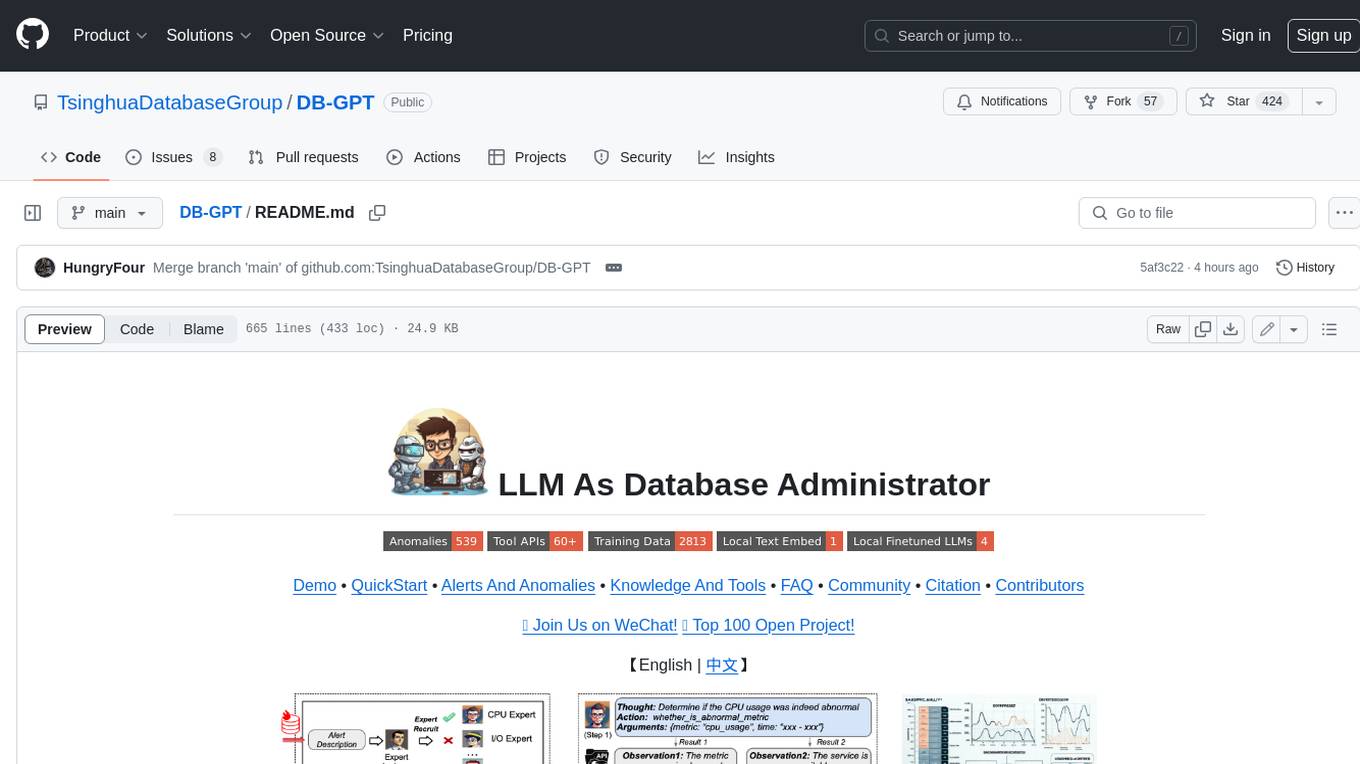
DB-GPT
DB-GPT is a personal database administrator that can solve database problems by reading documents, using various tools, and writing analysis reports. It is currently undergoing an upgrade. **Features:** * **Online Demo:** * Import documents into the knowledge base * Utilize the knowledge base for well-founded Q&A and diagnosis analysis of abnormal alarms * Send feedbacks to refine the intermediate diagnosis results * Edit the diagnosis result * Browse all historical diagnosis results, used metrics, and detailed diagnosis processes * **Language Support:** * English (default) * Chinese (add "language: zh" in config.yaml) * **New Frontend:** * Knowledgebase + Chat Q&A + Diagnosis + Report Replay * **Extreme Speed Version for localized llms:** * 4-bit quantized LLM (reducing inference time by 1/3) * vllm for fast inference (qwen) * Tiny LLM * **Multi-path extraction of document knowledge:** * Vector database (ChromaDB) * RESTful Search Engine (Elasticsearch) * **Expert prompt generation using document knowledge** * **Upgrade the LLM-based diagnosis mechanism:** * Task Dispatching -> Concurrent Diagnosis -> Cross Review -> Report Generation * Synchronous Concurrency Mechanism during LLM inference * **Support monitoring and optimization tools in multiple levels:** * Monitoring metrics (Prometheus) * Flame graph in code level * Diagnosis knowledge retrieval (dbmind) * Logical query transformations (Calcite) * Index optimization algorithms (for PostgreSQL) * Physical operator hints (for PostgreSQL) * Backup and Point-in-time Recovery (Pigsty) * **Continuously updated papers and experimental reports** This project is constantly evolving with new features. Don't forget to star ⭐ and watch 👀 to stay up to date.
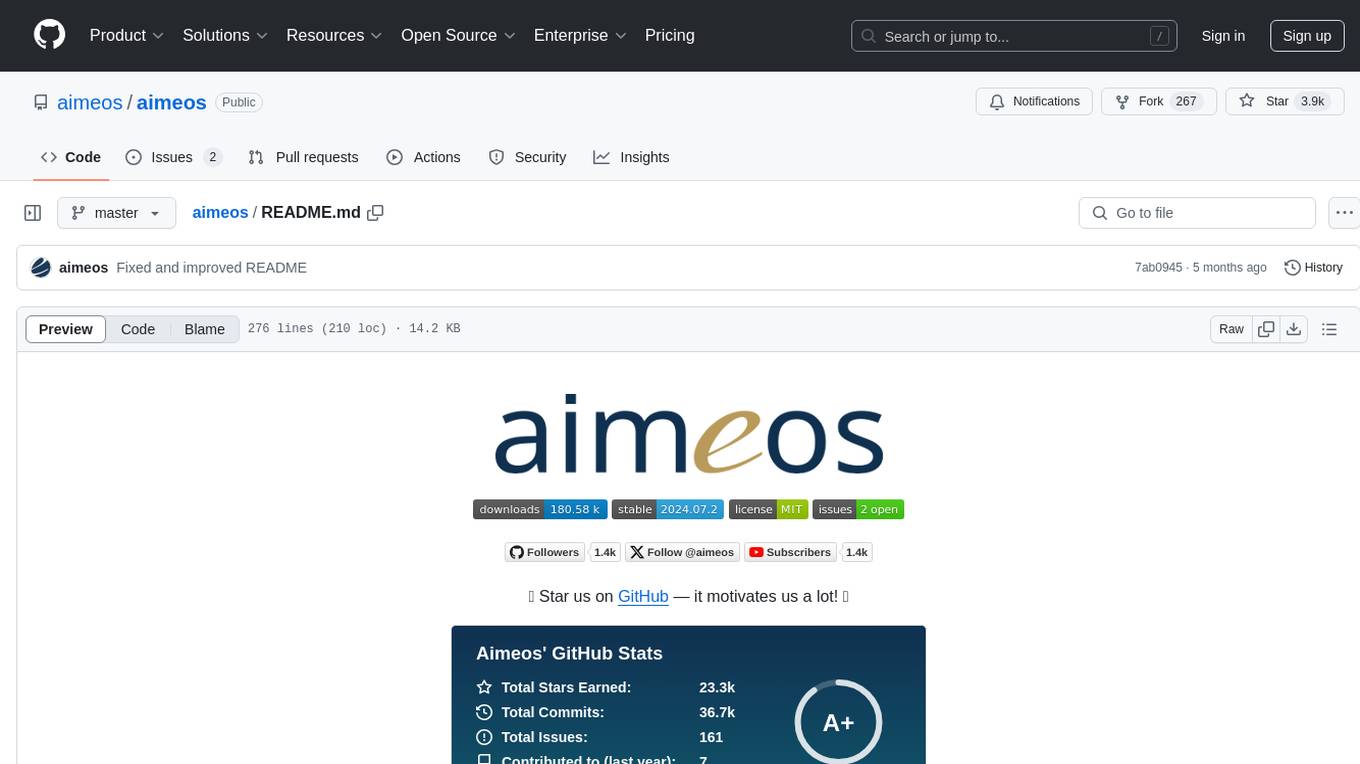
aimeos
Aimeos is a full-featured e-commerce platform that is ultra-fast, cloud-native, and API-first. It offers a wide range of features including JSON REST API, GraphQL API, multi-vendor support, various product types, subscriptions, multiple payment gateways, admin backend, modular structure, SEO optimization, multi-language support, AI-based text translation, mobile optimization, and high-quality source code. It is highly configurable and extensible, making it suitable for e-commerce SaaS solutions, marketplaces, and various cloud environments. Aimeos is designed for scalability, security, and performance, catering to a diverse range of e-commerce needs.
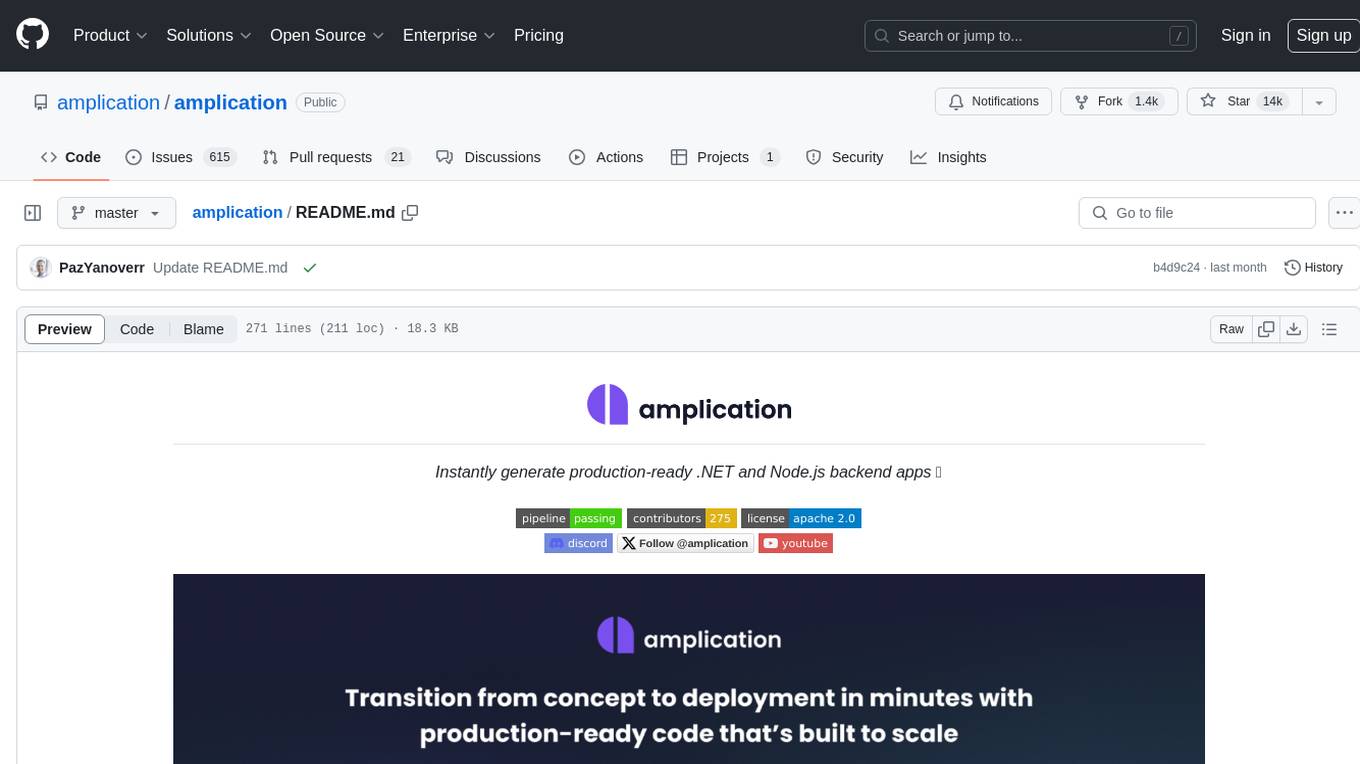
amplication
Amplication is a robust, open-source development platform designed to revolutionize the creation of scalable and secure .NET and Node.js applications. It automates backend applications development, ensuring consistency, predictability, and adherence to the highest standards with code that's built to scale. The user-friendly interface fosters seamless integration of APIs, data models, databases, authentication, and authorization. Built on a flexible, plugin-based architecture, Amplication allows effortless customization of the code and offers a diverse range of integrations. With a strong focus on collaboration, Amplication streamlines team-oriented development, making it an ideal choice for groups of all sizes, from startups to large enterprises. It enables users to concentrate on business logic while handling the heavy lifting of development. Experience the fastest way to develop .NET and Node.js applications with Amplication.
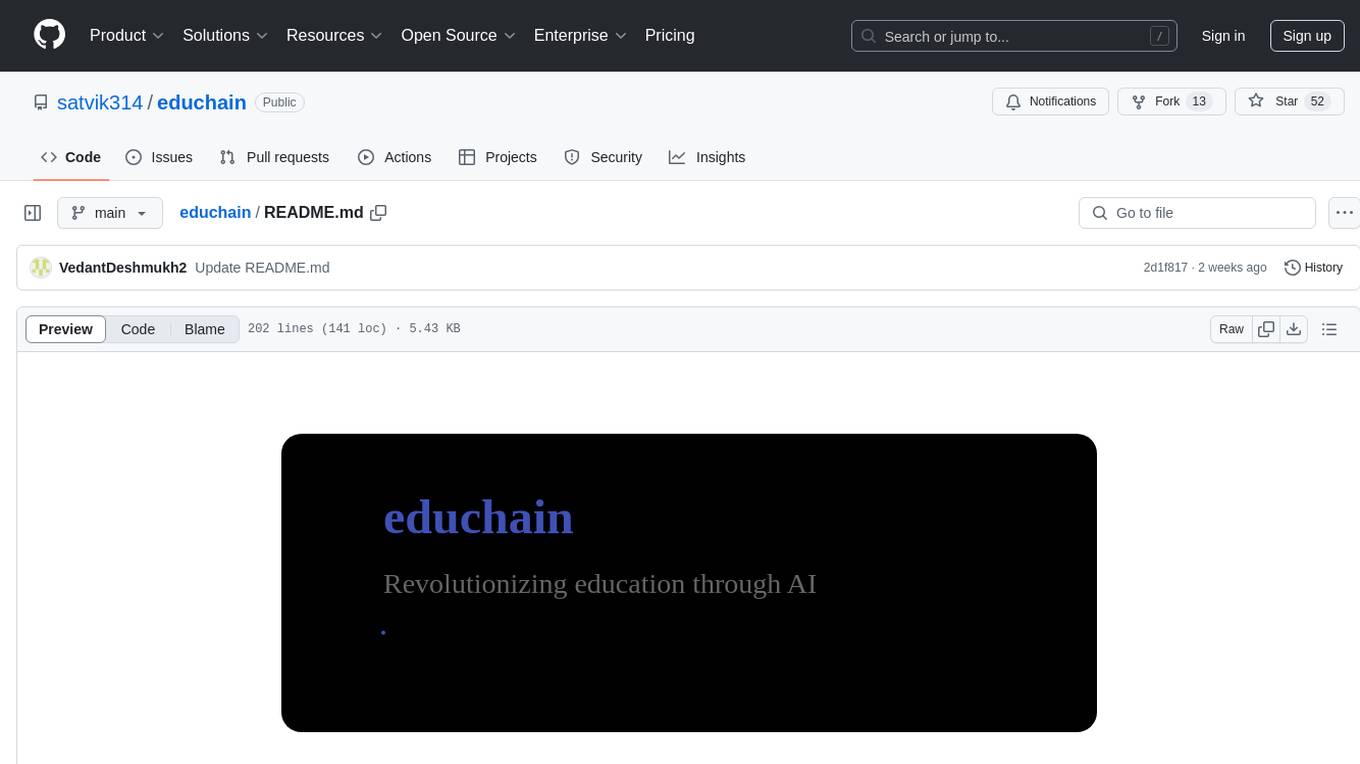
educhain
Educhain is a powerful Python package that leverages Generative AI to create engaging and personalized educational content. It enables users to generate multiple-choice questions, create lesson plans, and support various LLM models. Users can export questions to JSON, PDF, and CSV formats, customize prompt templates, and generate questions from text, PDF, URL files, youtube videos, and images. Educhain outperforms traditional methods in content generation speed and quality. It offers advanced configuration options and has a roadmap for future enhancements, including integration with popular Learning Management Systems and a mobile app for content generation on-the-go.
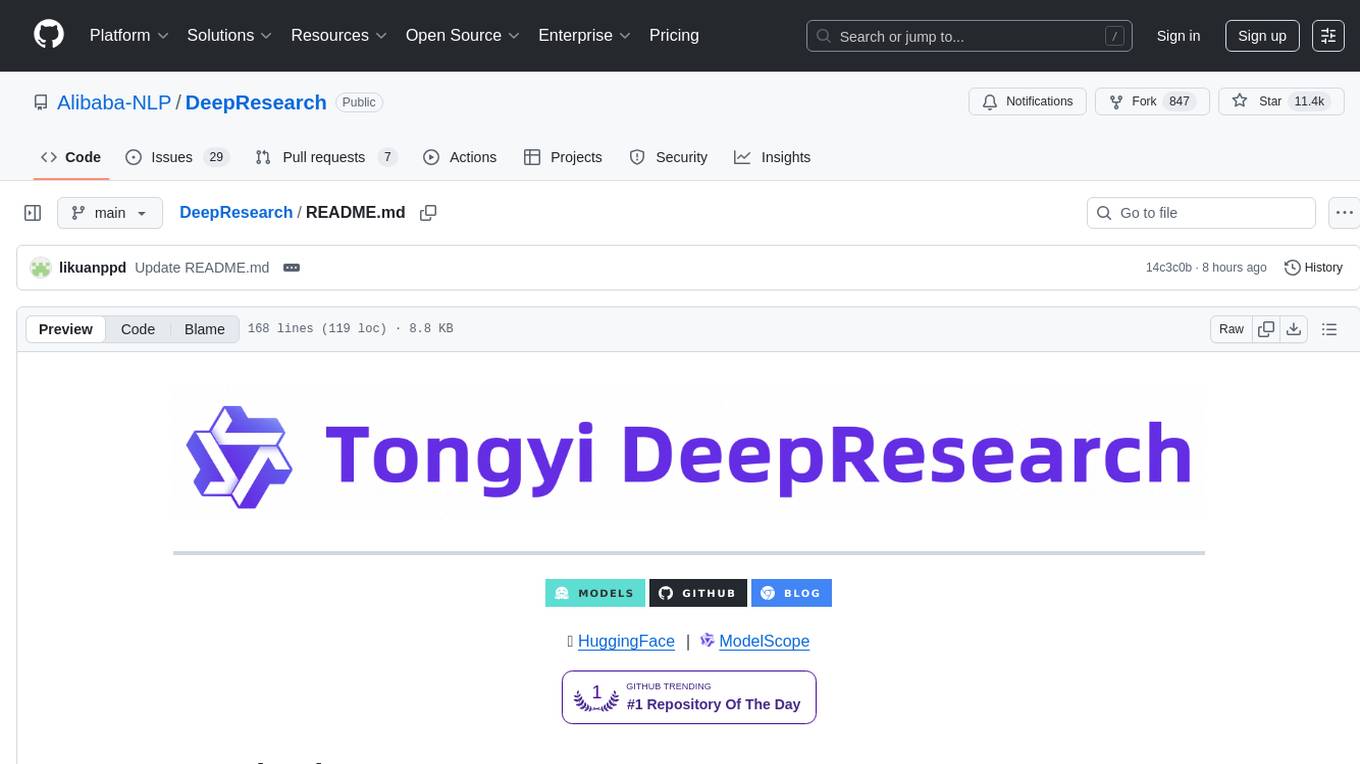
DeepResearch
Tongyi DeepResearch is an agentic large language model with 30.5 billion total parameters, designed for long-horizon, deep information-seeking tasks. It demonstrates state-of-the-art performance across various search benchmarks. The model features a fully automated synthetic data generation pipeline, large-scale continual pre-training on agentic data, end-to-end reinforcement learning, and compatibility with two inference paradigms. Users can download the model directly from HuggingFace or ModelScope. The repository also provides benchmark evaluation scripts and information on the Deep Research Agent Family.
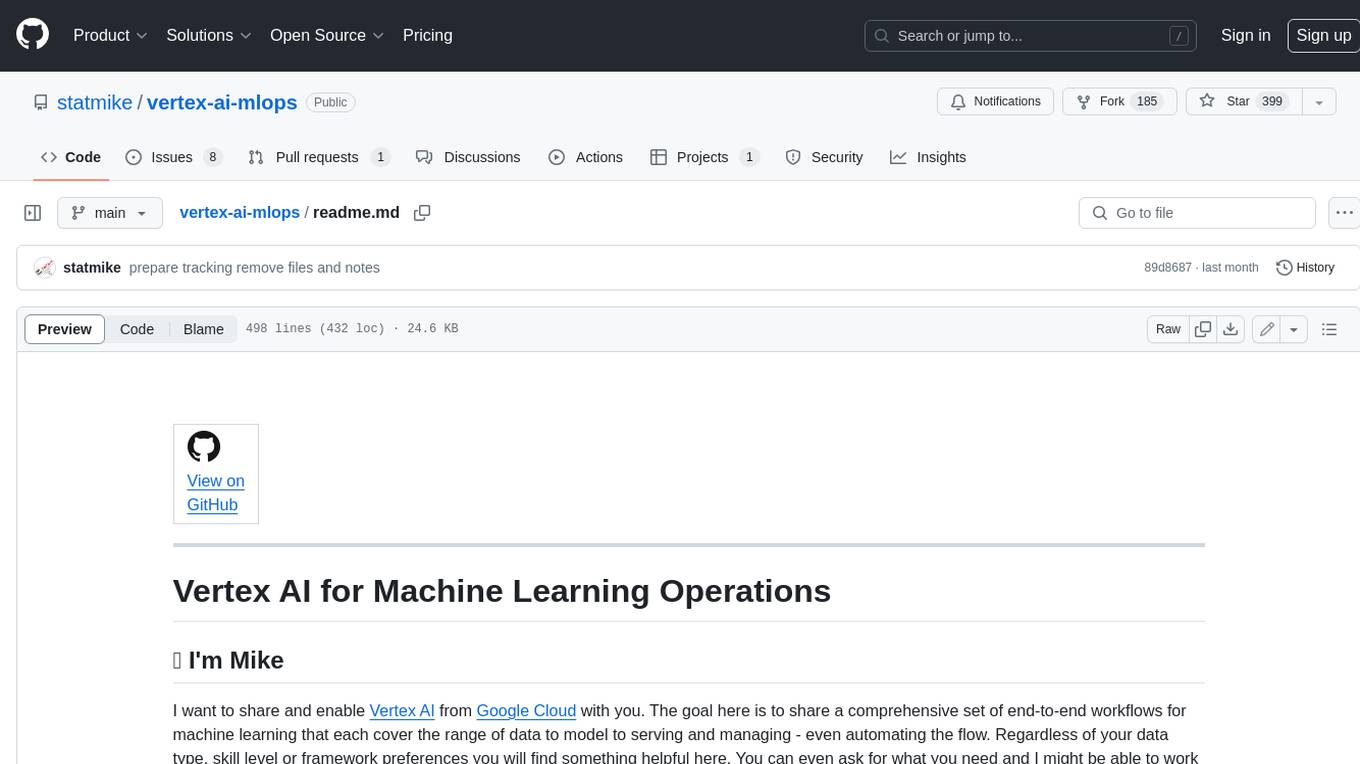
vertex-ai-mlops
Vertex AI is a platform for end-to-end model development. It consist of core components that make the processes of MLOps possible for design patterns of all types.
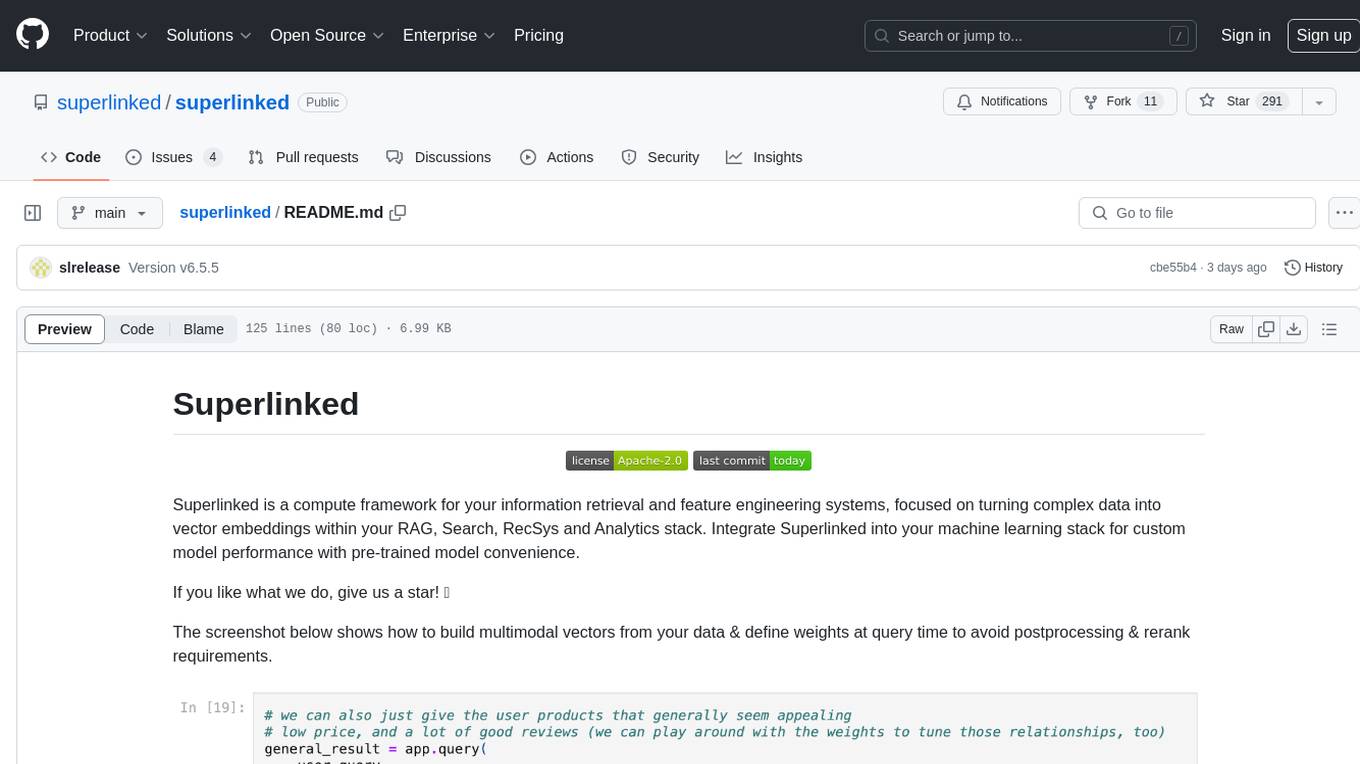
superlinked
Superlinked is a compute framework for information retrieval and feature engineering systems, focusing on converting complex data into vector embeddings for RAG, Search, RecSys, and Analytics stack integration. It enables custom model performance in machine learning with pre-trained model convenience. The tool allows users to build multimodal vectors, define weights at query time, and avoid postprocessing & rerank requirements. Users can explore the computational model through simple scripts and python notebooks, with a future release planned for production usage with built-in data infra and vector database integrations.
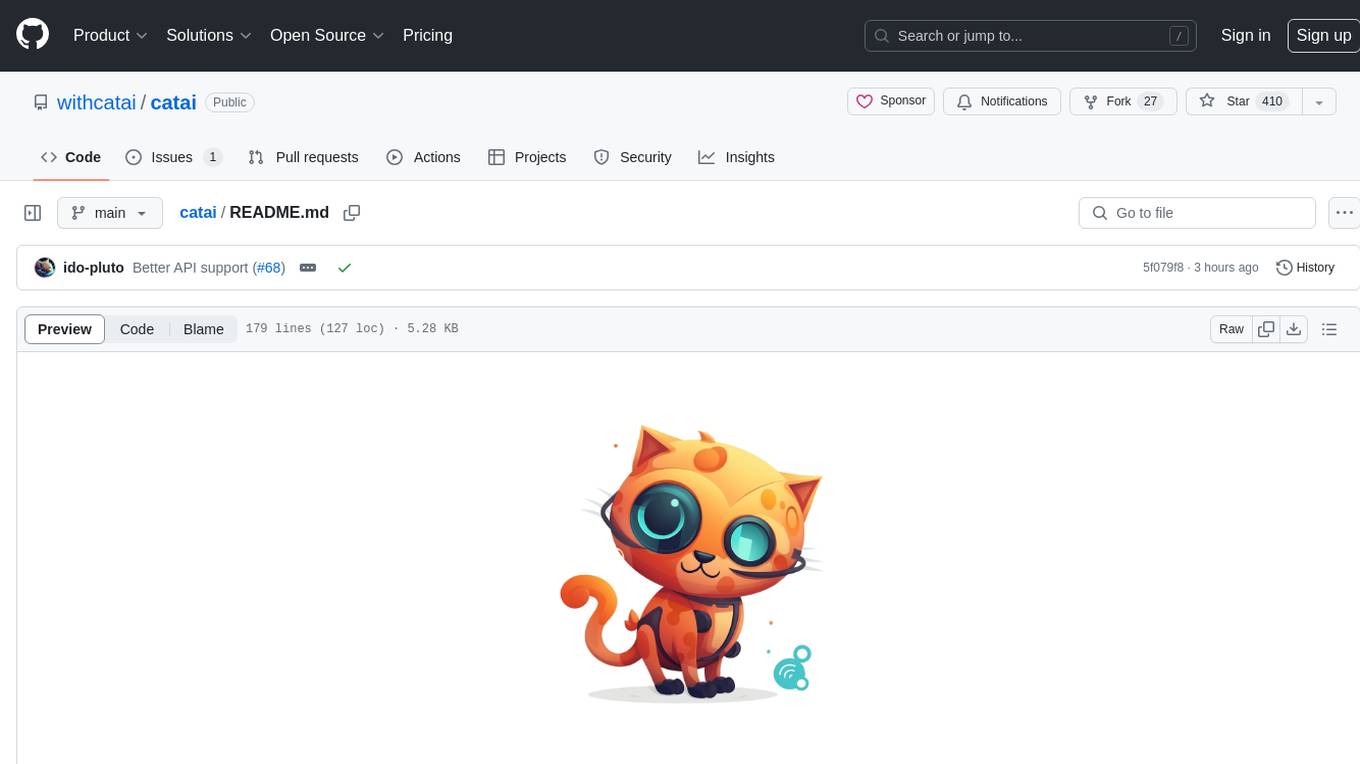
catai
CatAI is a tool that allows users to run GGUF models on their computer with a chat UI. It serves as a local AI assistant inspired by Node-Llama-Cpp and Llama.cpp. The tool provides features such as auto-detecting programming language, showing original messages by clicking on user icons, real-time text streaming, and fast model downloads. Users can interact with the tool through a CLI that supports commands for installing, listing, setting, serving, updating, and removing models. CatAI is cross-platform and supports Windows, Linux, and Mac. It utilizes node-llama-cpp and offers a simple API for asking model questions. Additionally, developers can integrate the tool with node-llama-cpp@beta for model management and chatting. The configuration can be edited via the web UI, and contributions to the project are welcome. The tool is licensed under Llama.cpp's license.
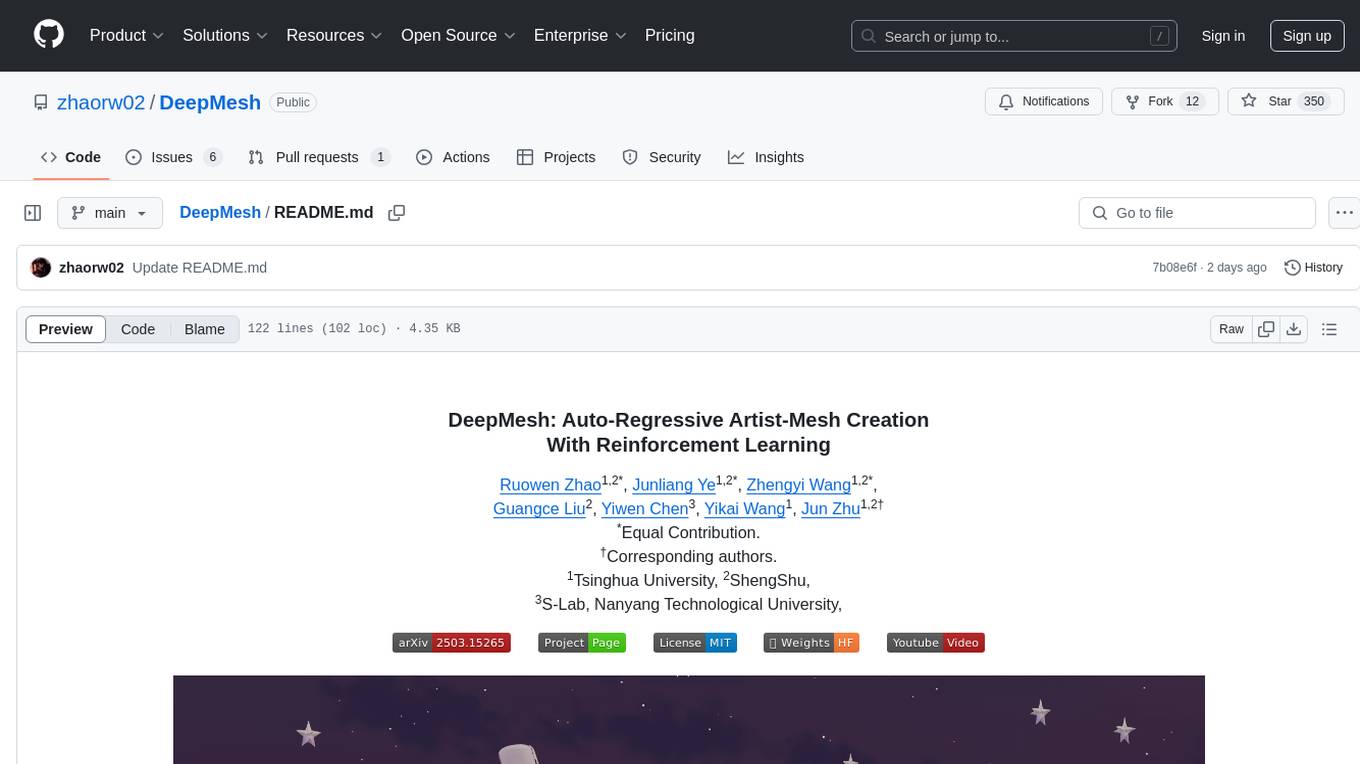
DeepMesh
DeepMesh is an auto-regressive artist-mesh creation tool that utilizes reinforcement learning to generate high-quality meshes conditioned on a given point cloud. It offers pretrained weights and allows users to generate obj/ply files based on specific input parameters. The tool has been tested on Ubuntu 22 with CUDA 11.8 and supports A100, A800, and A6000 GPUs. Users can clone the repository, create a conda environment, install pretrained model weights, and use command line inference to generate meshes.
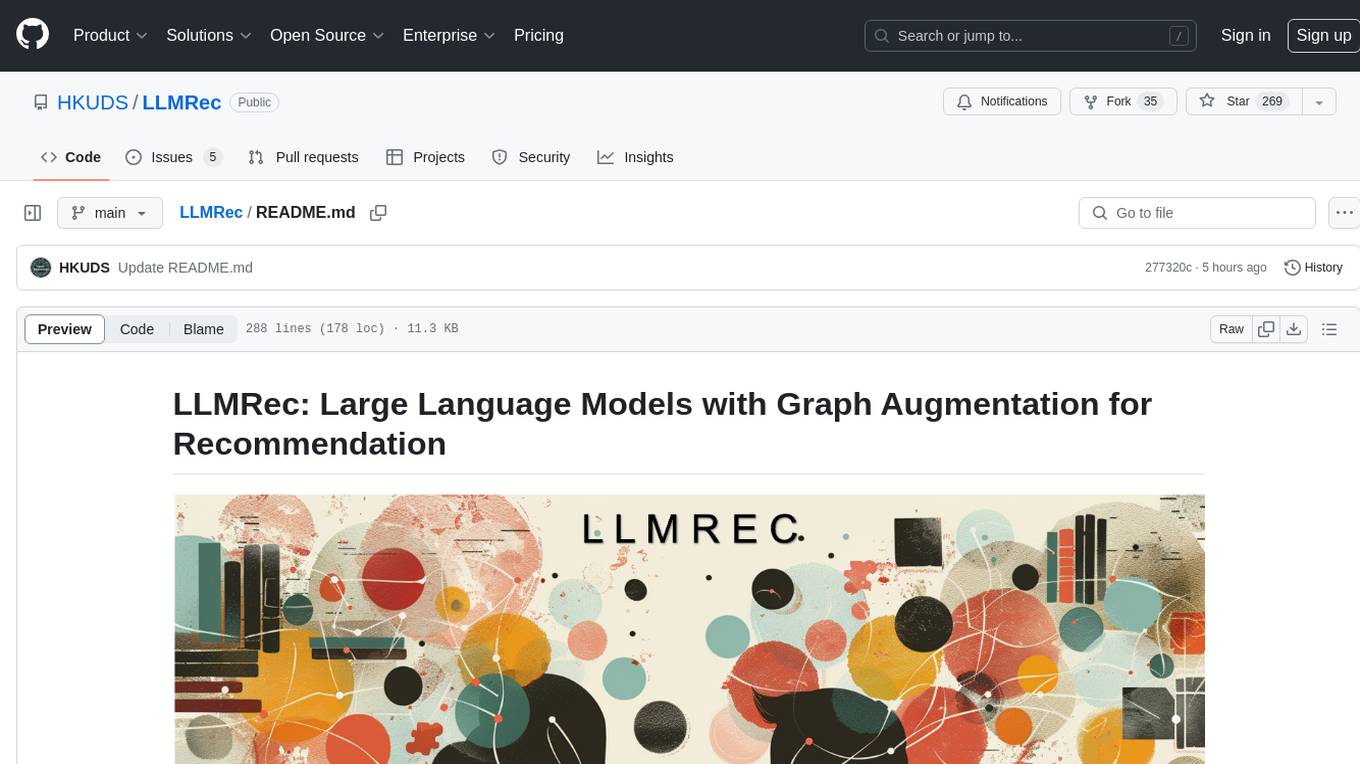
LLMRec
LLMRec is a PyTorch implementation for the WSDM 2024 paper 'Large Language Models with Graph Augmentation for Recommendation'. It is a novel framework that enhances recommenders by applying LLM-based graph augmentation strategies to recommendation systems. The tool aims to make the most of content within online platforms to augment interaction graphs by reinforcing u-i interactive edges, enhancing item node attributes, and conducting user node profiling from a natural language perspective.
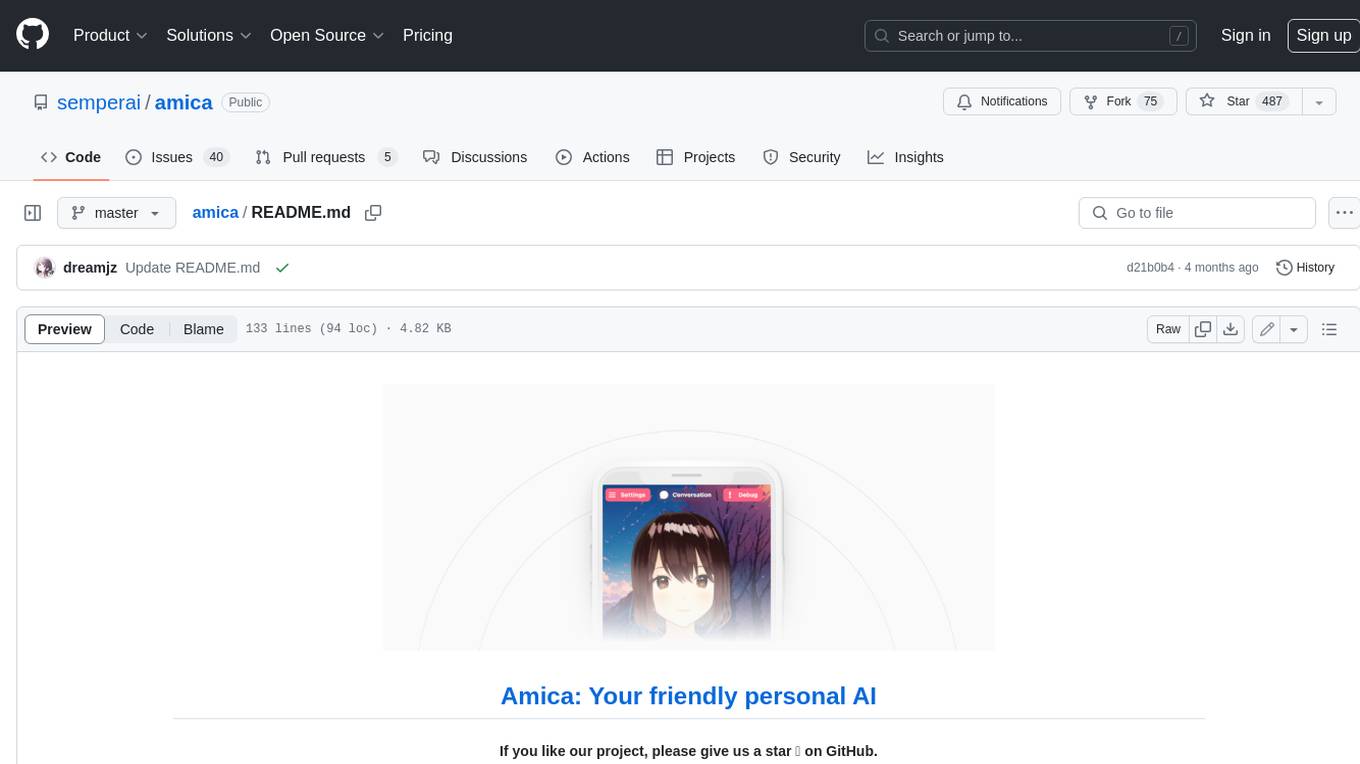
amica
Amica is an application that allows you to easily converse with 3D characters in your browser. You can import VRM files, adjust the voice to fit the character, and generate response text that includes emotional expressions.
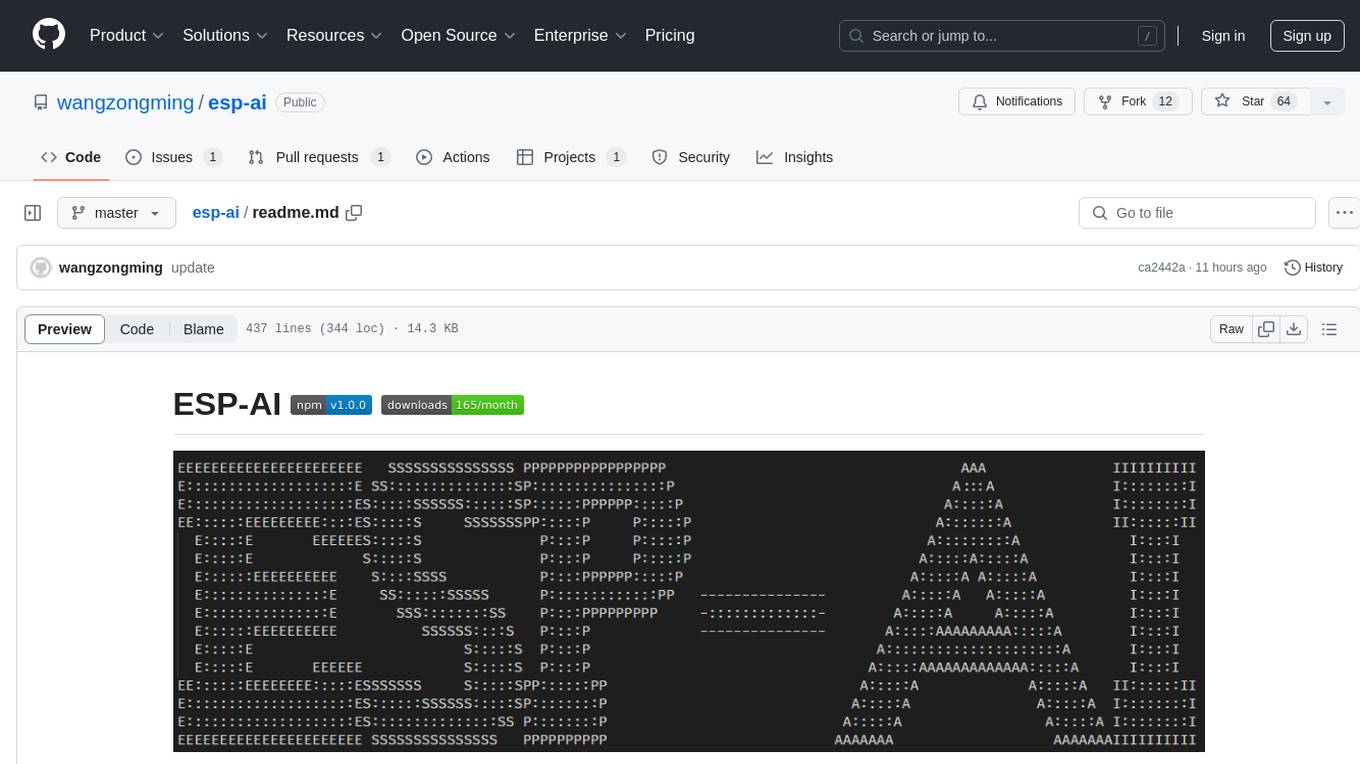
esp-ai
ESP-AI provides a complete AI conversation solution for your development board, including IAT+LLM+TTS integration solutions for ESP32 series development boards. It can be injected into projects without affecting existing ones. By providing keys from platforms like iFlytek, Jiling, and local services, you can run the services without worrying about interactions between services or between development boards and services. The project's server-side code is based on Node.js, and the hardware code is based on Arduino IDE.

rl
TorchRL is an open-source Reinforcement Learning (RL) library for PyTorch. It provides pytorch and **python-first** , low and high level abstractions for RL that are intended to be **efficient** , **modular** , **documented** and properly **tested**. The code is aimed at supporting research in RL. Most of it is written in python in a highly modular way, such that researchers can easily swap components, transform them or write new ones with little effort.
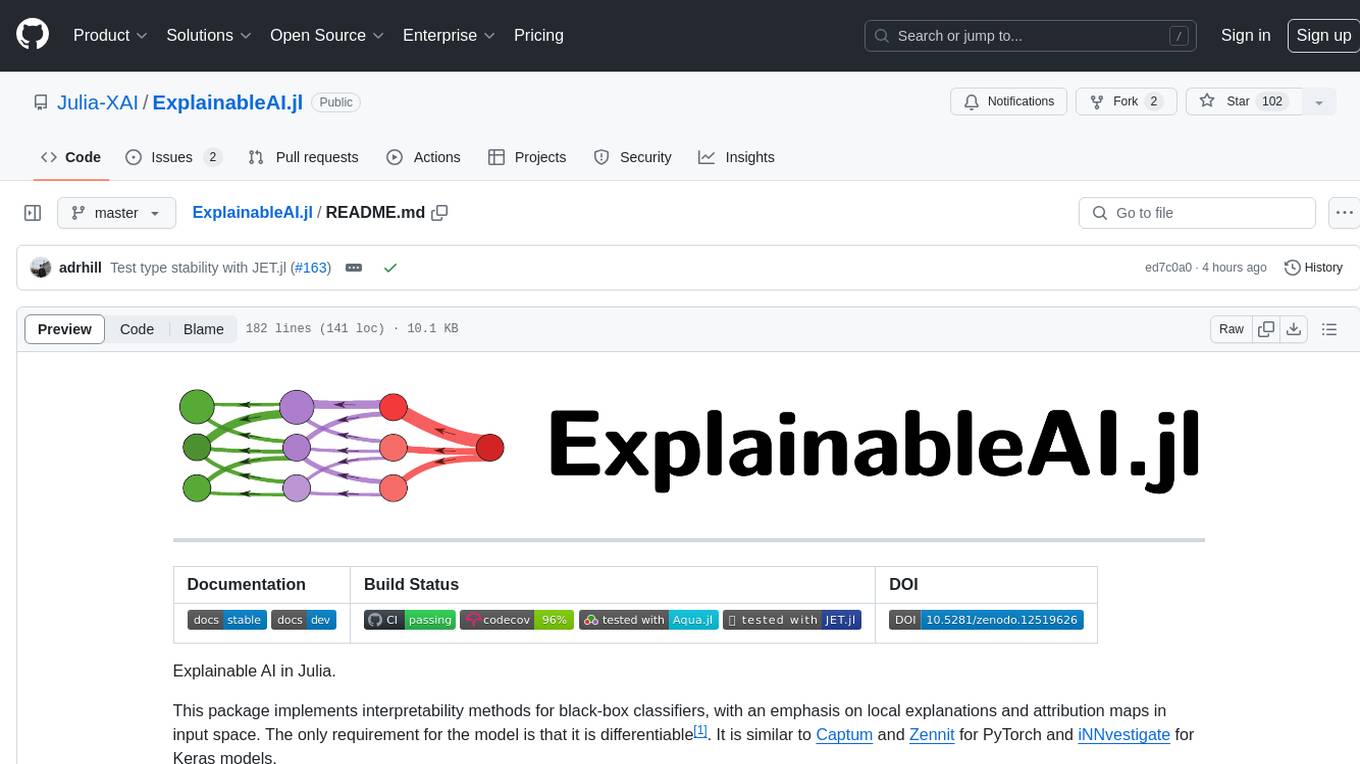
ExplainableAI.jl
ExplainableAI.jl is a Julia package that implements interpretability methods for black-box classifiers, focusing on local explanations and attribution maps in input space. The package requires models to be differentiable with Zygote.jl. It is similar to Captum and Zennit for PyTorch and iNNvestigate for Keras models. Users can analyze and visualize explanations for model predictions, with support for different XAI methods and customization. The package aims to provide transparency and insights into model decision-making processes, making it a valuable tool for understanding and validating machine learning models.
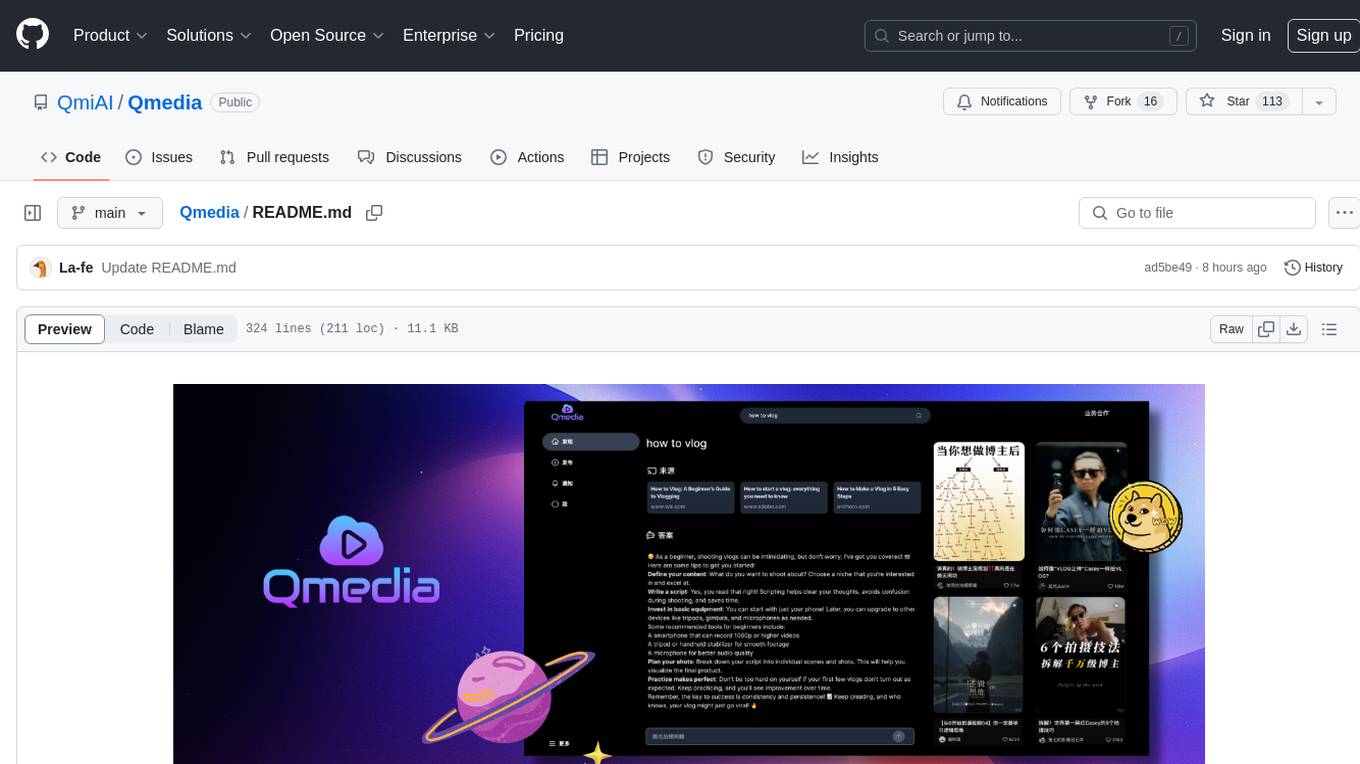
Qmedia
QMedia is an open-source multimedia AI content search engine designed specifically for content creators. It provides rich information extraction methods for text, image, and short video content. The tool integrates unstructured text, image, and short video information to build a multimodal RAG content Q&A system. Users can efficiently search for image/text and short video materials, analyze content, provide content sources, and generate customized search results based on user interests and needs. QMedia supports local deployment for offline content search and Q&A for private data. The tool offers features like content cards display, multimodal content RAG search, and pure local multimodal models deployment. Users can deploy different types of models locally, manage language models, feature embedding models, image models, and video models. QMedia aims to spark new ideas for content creation and share AI content creation concepts in an open-source manner.
For similar tasks

dom-to-semantic-markdown
DOM to Semantic Markdown is a tool that converts HTML DOM to Semantic Markdown for use in Large Language Models (LLMs). It maximizes semantic information, token efficiency, and preserves metadata to enhance LLMs' processing capabilities. The tool captures rich web content structure, including semantic tags, image metadata, table structures, and link destinations. It offers customizable conversion options and supports both browser and Node.js environments.
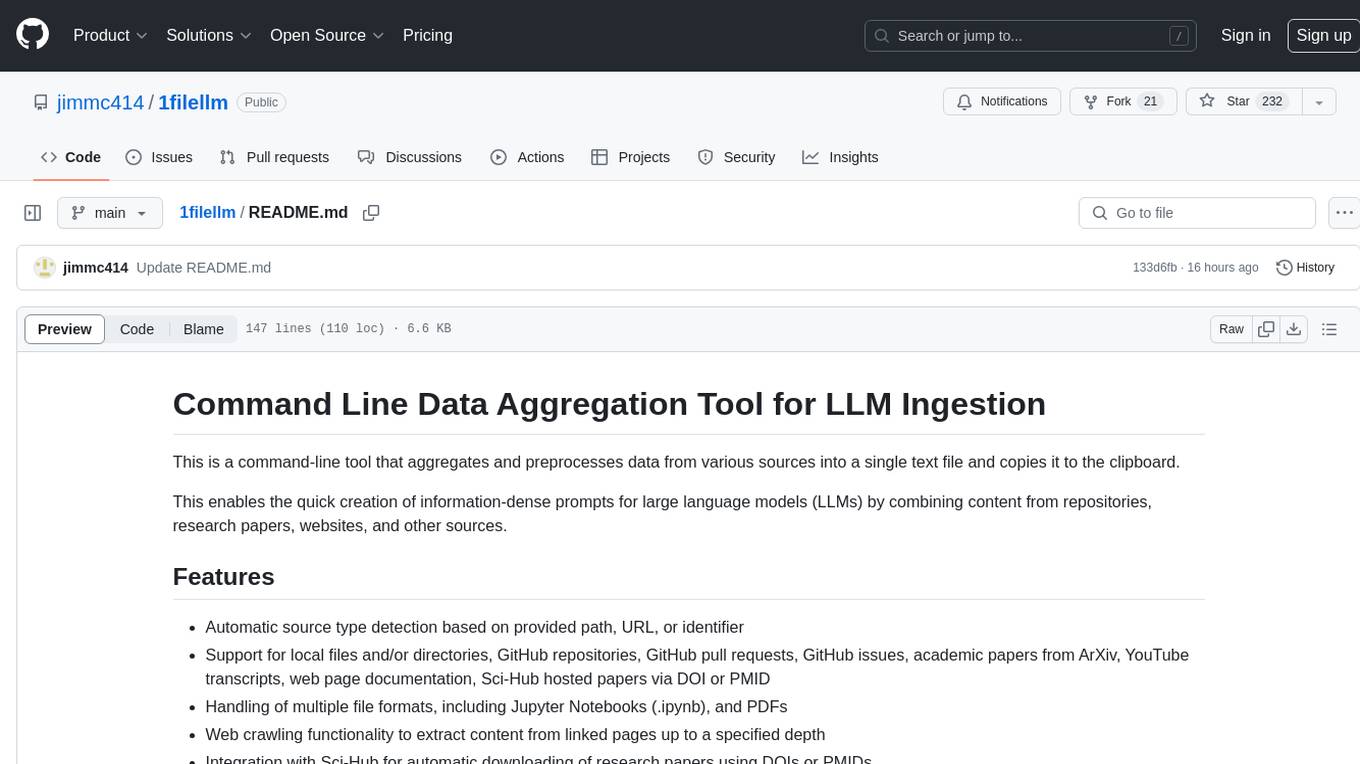
1filellm
1filellm is a command-line data aggregation tool designed for LLM ingestion. It aggregates and preprocesses data from various sources into a single text file, facilitating the creation of information-dense prompts for large language models. The tool supports automatic source type detection, handling of multiple file formats, web crawling functionality, integration with Sci-Hub for research paper downloads, text preprocessing, and token count reporting. Users can input local files, directories, GitHub repositories, pull requests, issues, ArXiv papers, YouTube transcripts, web pages, Sci-Hub papers via DOI or PMID. The tool provides uncompressed and compressed text outputs, with the uncompressed text automatically copied to the clipboard for easy pasting into LLMs.
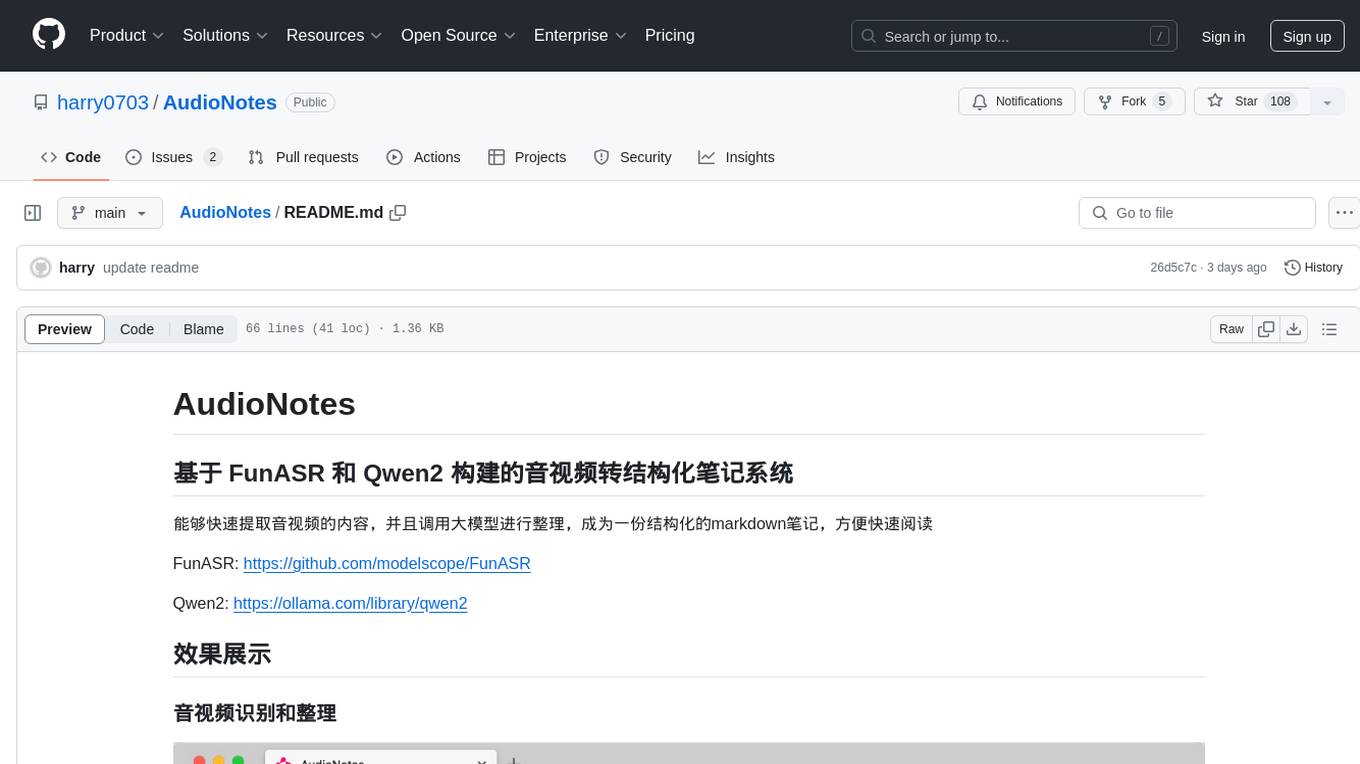
AudioNotes
AudioNotes is a system built on FunASR and Qwen2 that can quickly extract content from audio and video, and organize it using large models into structured markdown notes for easy reading. Users can interact with the audio and video content, install Ollama, pull models, and deploy services using Docker or locally with a PostgreSQL database. The system provides a seamless way to convert audio and video into structured notes for efficient consumption.
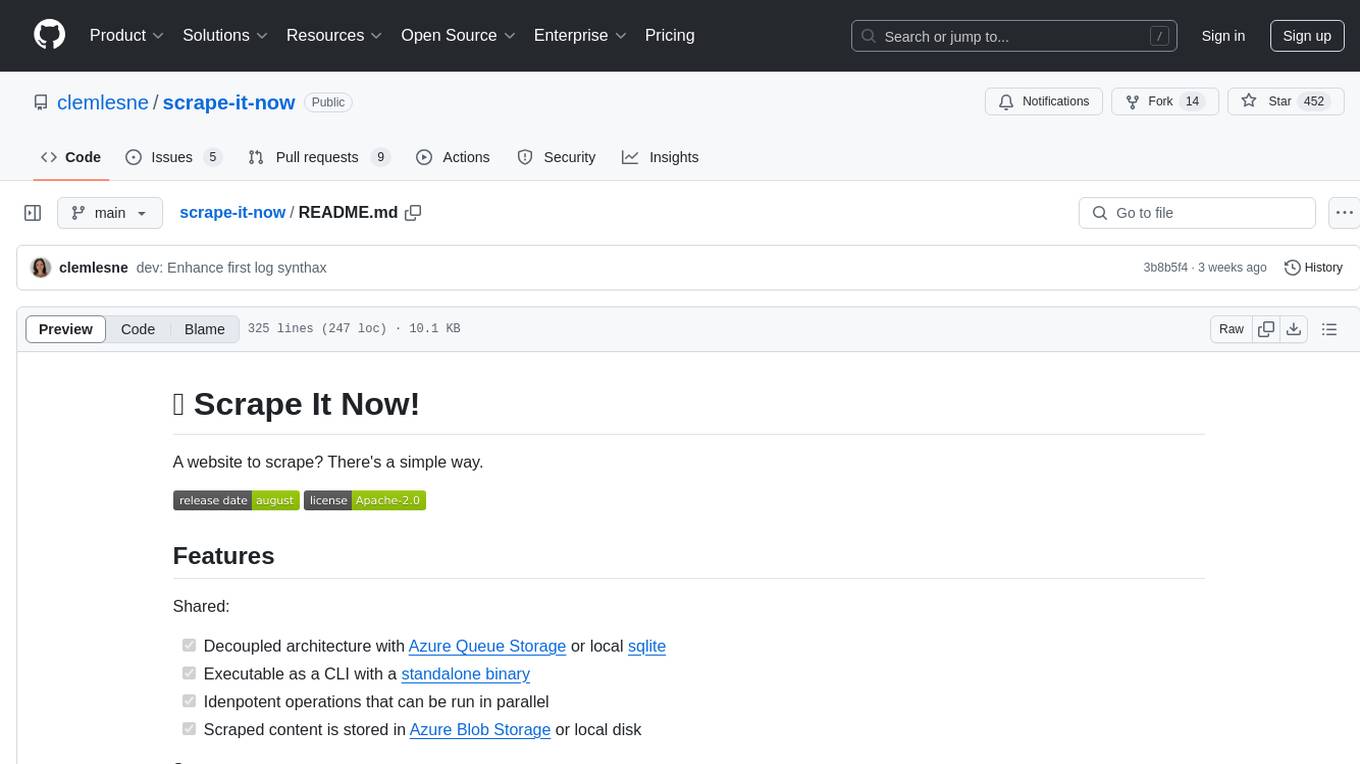
scrape-it-now
Scrape It Now is a versatile tool for scraping websites with features like decoupled architecture, CLI functionality, idempotent operations, and content storage options. The tool includes a scraper component for efficient scraping, ad blocking, link detection, markdown extraction, dynamic content loading, and anonymity features. It also offers an indexer component for creating AI search indexes, chunking content, embedding chunks, and enabling semantic search. The tool supports various configurations for Azure services and local storage, providing flexibility and scalability for web scraping and indexing tasks.

open-deep-research
Open Deep Research is an open-source tool designed to generate AI-powered reports from web search results efficiently. It combines Bing Search API for search results retrieval, JinaAI for content extraction, and customizable report generation. Users can customize settings, export reports in multiple formats, and benefit from rate limiting for stability. The tool aims to streamline research and report creation in a user-friendly platform.

DevDocs
DevDocs is a platform designed to simplify the process of digesting technical documentation for software engineers and developers. It automates the extraction and conversion of web content into markdown format, making it easier for users to access and understand the information. By crawling through child pages of a given URL, DevDocs provides a streamlined approach to gathering relevant data and integrating it into various tools for software development. The tool aims to save time and effort by eliminating the need for manual research and content extraction, ultimately enhancing productivity and efficiency in the development process.
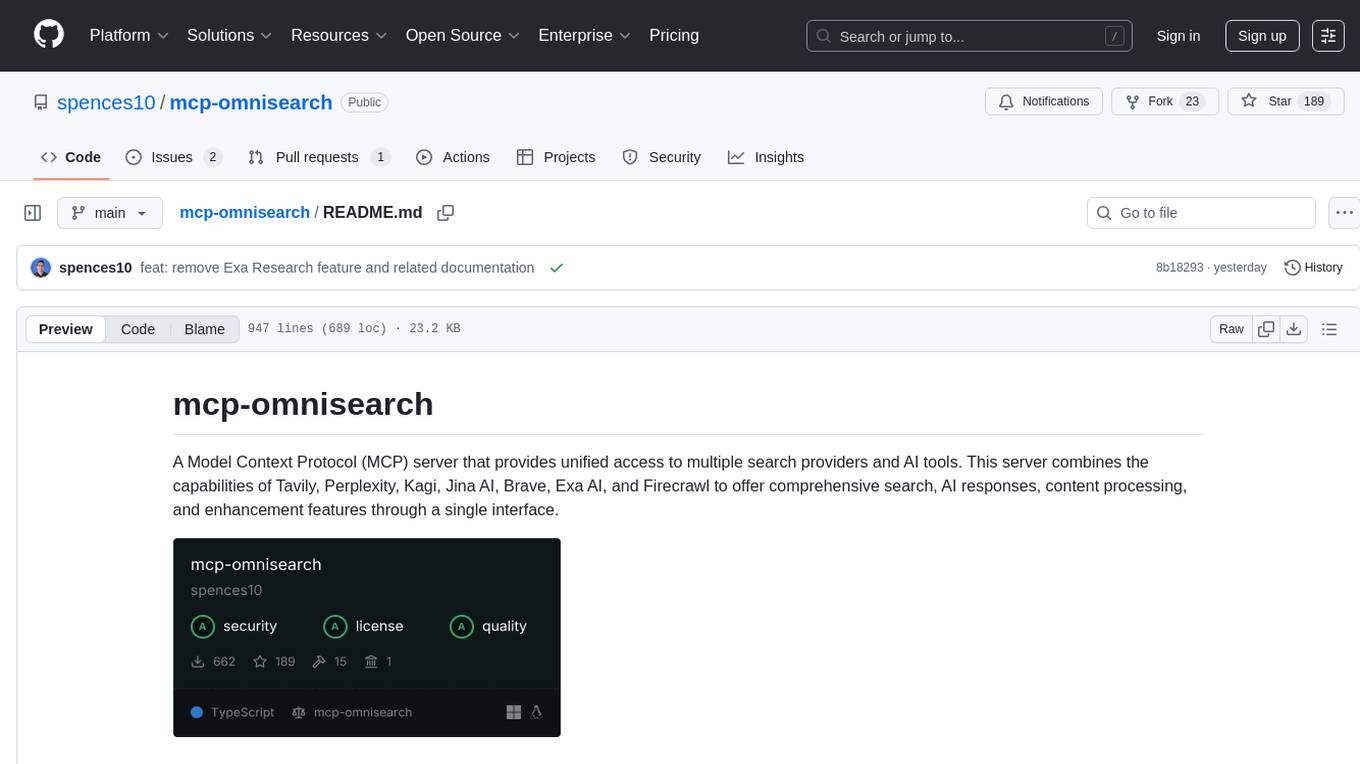
mcp-omnisearch
mcp-omnisearch is a Model Context Protocol (MCP) server that acts as a unified gateway to multiple search providers and AI tools. It integrates Tavily, Perplexity, Kagi, Jina AI, Brave, Exa AI, and Firecrawl to offer a wide range of search, AI response, content processing, and enhancement features through a single interface. The server provides powerful search capabilities, AI response generation, content extraction, summarization, web scraping, structured data extraction, and more. It is designed to work flexibly with the API keys available, enabling users to activate only the providers they have keys for and easily add more as needed.
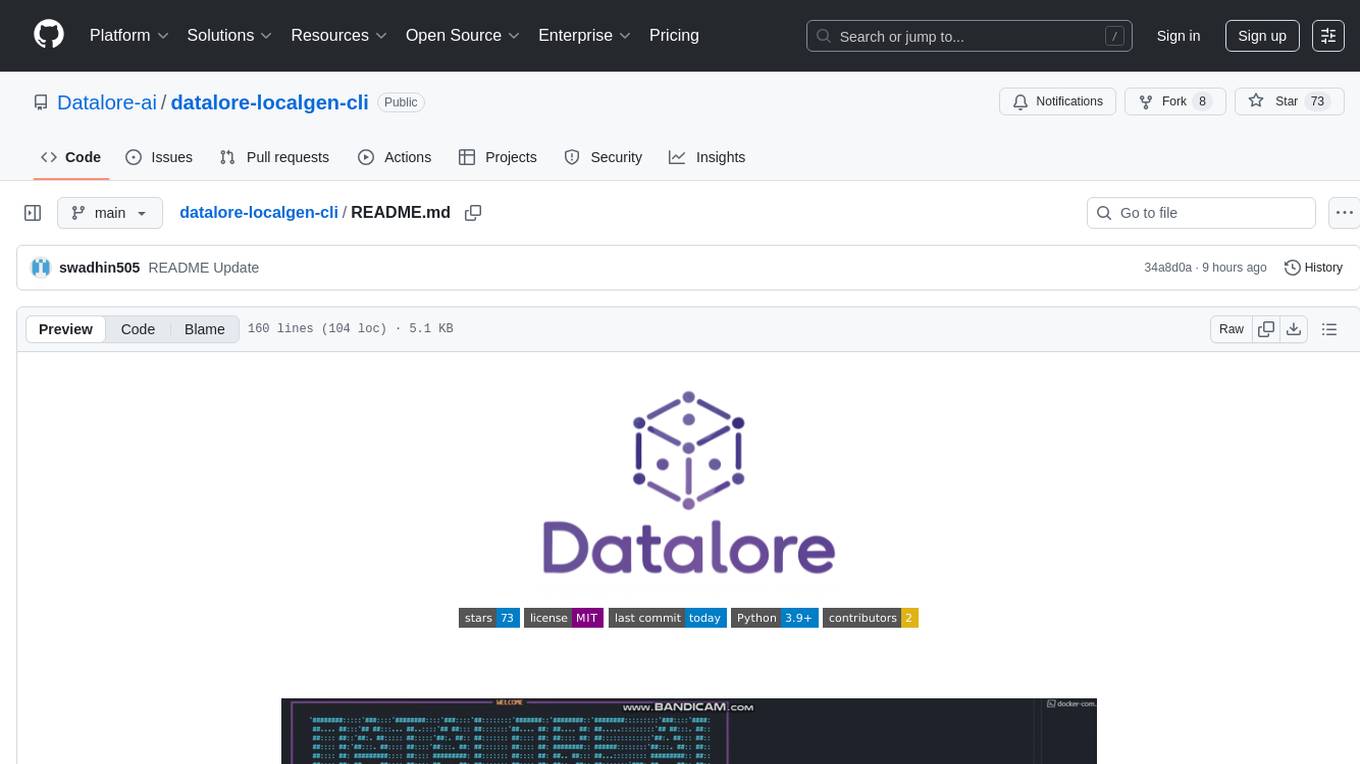
datalore-localgen-cli
Datalore is a terminal tool for generating structured datasets from local files like PDFs, Word docs, images, and text. It extracts content, uses semantic search to understand context, applies instructions through a generated schema, and outputs clean, structured data. Perfect for converting raw or unstructured local documents into ready-to-use datasets for training, analysis, or experimentation, all without manual formatting.
For similar jobs

weave
Weave is a toolkit for developing Generative AI applications, built by Weights & Biases. With Weave, you can log and debug language model inputs, outputs, and traces; build rigorous, apples-to-apples evaluations for language model use cases; and organize all the information generated across the LLM workflow, from experimentation to evaluations to production. Weave aims to bring rigor, best-practices, and composability to the inherently experimental process of developing Generative AI software, without introducing cognitive overhead.

LLMStack
LLMStack is a no-code platform for building generative AI agents, workflows, and chatbots. It allows users to connect their own data, internal tools, and GPT-powered models without any coding experience. LLMStack can be deployed to the cloud or on-premise and can be accessed via HTTP API or triggered from Slack or Discord.

VisionCraft
The VisionCraft API is a free API for using over 100 different AI models. From images to sound.

kaito
Kaito is an operator that automates the AI/ML inference model deployment in a Kubernetes cluster. It manages large model files using container images, avoids tuning deployment parameters to fit GPU hardware by providing preset configurations, auto-provisions GPU nodes based on model requirements, and hosts large model images in the public Microsoft Container Registry (MCR) if the license allows. Using Kaito, the workflow of onboarding large AI inference models in Kubernetes is largely simplified.

PyRIT
PyRIT is an open access automation framework designed to empower security professionals and ML engineers to red team foundation models and their applications. It automates AI Red Teaming tasks to allow operators to focus on more complicated and time-consuming tasks and can also identify security harms such as misuse (e.g., malware generation, jailbreaking), and privacy harms (e.g., identity theft). The goal is to allow researchers to have a baseline of how well their model and entire inference pipeline is doing against different harm categories and to be able to compare that baseline to future iterations of their model. This allows them to have empirical data on how well their model is doing today, and detect any degradation of performance based on future improvements.

tabby
Tabby is a self-hosted AI coding assistant, offering an open-source and on-premises alternative to GitHub Copilot. It boasts several key features: * Self-contained, with no need for a DBMS or cloud service. * OpenAPI interface, easy to integrate with existing infrastructure (e.g Cloud IDE). * Supports consumer-grade GPUs.

spear
SPEAR (Simulator for Photorealistic Embodied AI Research) is a powerful tool for training embodied agents. It features 300 unique virtual indoor environments with 2,566 unique rooms and 17,234 unique objects that can be manipulated individually. Each environment is designed by a professional artist and features detailed geometry, photorealistic materials, and a unique floor plan and object layout. SPEAR is implemented as Unreal Engine assets and provides an OpenAI Gym interface for interacting with the environments via Python.

Magick
Magick is a groundbreaking visual AIDE (Artificial Intelligence Development Environment) for no-code data pipelines and multimodal agents. Magick can connect to other services and comes with nodes and templates well-suited for intelligent agents, chatbots, complex reasoning systems and realistic characters.
